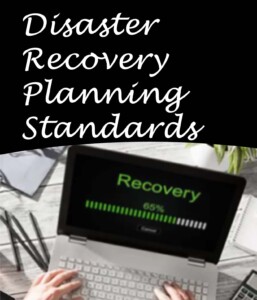Disaster recovery planning standards are crucial for ensuring business continuity in the face of unexpected disruptions. A Business Resumption Plan (BRP) outlines strategies and procedures to resume operations swiftly after a disaster, minimizing downtime and mitigating financial losses. Adhering to recognized standards such as  those set by the International Organization for Standardization (ISO) or the National Institute of Standards and Technology (NIST) provides businesses with a framework for developing comprehensive disaster recovery plans. These standards typically include risk assessment methodologies, contingency planning, backup and recovery procedures, and communication protocols to ensure a coordinated response across all levels of the organization.
those set by the International Organization for Standardization (ISO) or the National Institute of Standards and Technology (NIST) provides businesses with a framework for developing comprehensive disaster recovery plans. These standards typically include risk assessment methodologies, contingency planning, backup and recovery procedures, and communication protocols to ensure a coordinated response across all levels of the organization.
Implementing disaster recovery planning standards not only enhances a company’s ability to recover from disasters but also instills confidence among stakeholders, including customers, investors, and regulatory bodies. By following established guidelines, businesses can systematically identify vulnerabilities, prioritize critical assets, and allocate resources effectively to minimize the impact of disruptions. Moreover, compliance with recognized standards demonstrates a commitment to resilience and fosters a culture of preparedness within the organization. With a robust Business Resumption Plan, businesses can navigate unforeseen challenges with greater agility and safeguard their long-term viability in an increasingly unpredictable environment.
Sample from template
The following required and/or recommended information inputs should be completed using the full electronic version of the Disaster Recovery Plan Template and the Technology Components Recovery Plan Templates. These templates can be obtained. Those sections marked with a “Required” are required to be completed. Sections with a “Recommended” and “Optional” are optional.
A. General Information
Confidentiality Statement (Required)
All your documents should remain confidential to your company. You will need to put a confident statement in this section. If your company has a confidentiality statement that is used for all documents, use that here.
Plan Maintenance (Required)
Document all revisions, deletions, additions, etc. that have been made to this document.
- Record the Version of the Document that is located at the Top Right-hand side on the cover page.
- Record the description of the change (i.e.: updated contact information.)
- Identify the chapter, section, and page that was updated.
- Document the name of the person who made the change.
- Record the date the change was made.
This log should be kept with the document at all times. Never delete revision history. Just keep expanding the table.
Plan Exercise (Required)
Document any exercises (tests) that have been conducted using this plan. This will help the auditing of the plans by providing information about the testing activities that have taken place.
- Record the date of the tests.
- Identify the type of exercise that was conducted. (Call Tree, Walkthrough, Table Top, etc.)
- Record the results of the exercise. (It was successful, etc.)
Table of Contents for Disaster Recovery Planning Standard
TERMINOLOGY
ACCOUNTABILITY
COMPLIANCE
I. DISASTER RECOVERY PLANNING STANDARDS
B. Executive Summary
C. Scope & Objectives
D. Recovery Strategy
E. Plan Assumptions & Exposures
F. Disaster Declaration Procedures
G. Recovery Teams
H. Contact Lists
I. Alternate Locations
J. Plan Certification
II. APPLICATION RECOVERY PLAN STANDARDS
B. Plan Introduction
C. Application Profile
D. Plan Activation Procedures
E. Team Members & Responsibilities
F. Recovery Procedures
G. Contact Lists
H. Alternate Locations
I. Restoration of Normal Operations
III. SERVER RECOVERY PLAN STANDARDS
B. Plan Introduction
C. Server Profile
D. Plan Activation Procedures
E. Team Members & Responsibilities
F. Recovery Procedures
G. Contact Lists
H. Alternate Locations
I. Restoration of Normal Operations
IV. NETWORK RECOVERY PLAN STANDARDS
B. Plan Introduction
C. Network Profile
D. Plan Activation Procedures
E. Team Members & Responsibilities
F. Recovery Procedures
G. Contact Lists
H. Alternate Locations
I. Restoration of Normal Operations
V. TELECOMMUNICATIONS RECOVERY PLAN STANDARDS
B. Plan Introduction
C. Telecommunication Profile
D. Plan Activation Procedures
E. Team Members & Responsibilities
F. Recovery Procedures
G. Contact Lists
H. Alternate Locations
I. Restoration of Normal Operations
VI. DATABASE RECOVERY PLAN STANDARDS
B. Plan Introduction
C. Database Profile
D. Plan Activation Procedures
E. Team Members & Responsibilities
F. Recovery Procedures
G. Contact Lists
H. Alternate Locations
I. Restoration of Normal Operations
To view a specific section of this document, please contact us at Bob@supremusgroup.com or call us at (515) 865-4591.
To buy individual template packages, visit the following links:
- Components of the Business Resumption Plan Templates Suite
- Hospital Disaster Recovery & Business Continuity Plan Template Suite
- Testimonials
- FAQ on Bussiness Resumption Plan Templates for Business Continuity & Disaster Recovery
- License Agreement
- Business Impact Analysis Template Packages
- Risk Assessment Template Packages
- Data Center Recovery Template Packages
- BCP & DRP Template Packages
